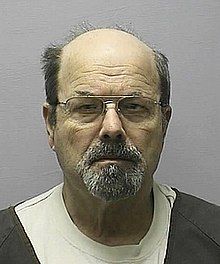Serial Killers
The Capture of Serial Killer Dennis Rader, BTK
Undone by his egomania and a floppy disk.
Posted February 1, 2023 Reviewed by Vanessa Lancaster
Key points
- Rader was duped and outwitted by a cunning police detective.
- The detective prodded Rader's egomania, which helped lower his guard.
- Rader felt betrayed by the police lieutenant who deceived and captured him.

In 2004, Dennis Rader, the infamous but unidentified serial killer known as “Bind, Torture, Kill” or BTK, who terrorized Wichita, Kansas, had not claimed a new victim for 13 years. The investigation of his crimes, headed by Wichita Police Lieutenant Ken Landwehr, had gone completely cold.
News stories marking the thirtieth anniversary of his first killings (the 1974 Otero family murders) started to appear in the local and even national media. Rader began to miss his notoriety as BTK, and he also hungered for a new victim.
BTK abruptly resurfaced, and he began communicating with the police and media after a local news report speculated that he was either dead or in prison. Rader could not resist the temptation to refute the rumors publicly. Over the next 11 months leading up to his arrest, he sent 10 taunting messages to authorities, many of them directly to Ken Landwehr, with whom Rader thought he had a special rapport.
He asked Landwehr whether he could communicate with him via a floppy disk without it being traced to a particular computer. Landwehr naturally lied and said yes. A few weeks later, a floppy disk from BTK addressed to Landwehr arrived at a local television station. The disk was quickly traced to Rader through a computer at the local Lutheran church where he was president of the congregation.
Rader was very disappointed about the perceived betrayal by Landwehr, and he expressed shock during his jailhouse interrogation that the police lieutenant would intentionally deceive him.
Speaking directly to Landwehr and using the lieutenant’s first name, Rader said, “I need to ask you, Ken, how come you lied to me?”
In a matter-of-fact tone, Landwehr coolly replied, “Because I was trying to catch you.” Rader later admitted that the floppy disk “did me in.”
Although it seems inconceivable that Rader would trust Landwehr so completely, it can be attributed to his grandiosity and sense of invulnerability. As noted by the late FBI profiler Roy Hazelwood, with whom I corresponded, “He apparently believed that Landwehr couldn’t afford to lie to him because he knew if he did, Rader would cut off communications with him.”
I believe that Rader felt a kinship or bond to Ken Landwehr, which is supported by the fact that he told the lieutenant at one point during his interrogation that they were fellow law enforcement officers. Rader had wanted badly to be a police officer, which exposed a weakness in him. He let down his guard with Landwehr, and the savvy detective took advantage of the opening with a knockout punch.
Rader was arrested on February 25, 2005, and was later charged with 10 counts of first-degree murder. Friends, neighbors, and members of his church were stunned by the news and could not believe that the innocuous-seeming man they knew was actually the stone-cold serial killer who had haunted the area for so many years. To the surprise of many, Rader pled guilty to all charges on June 27, 2005.
Rader escaped the death penalty because he committed his crimes before the state of Kansas reinstated capital punishment in 1994. His sentencing hearing in August 2005 was the first opportunity for relatives of his victims to confront him in person as they made their so-called impact statements to the court. The hearing revealed more gruesome details about his murders. Many courtroom observers noted that Rader described the horrible events with emotional detachment and without remorse–almost like he was giving a presentation.
He explained, for example, that he threw his last victim, Dolores Davis’s body, under a bridge but returned to it later. Although her corpse was decomposed by the time he returned, he placed a feminine mask over her face and photographed her body for later use in autoerotic fantasies, in which he relived his horrible crimes with the aid of trophies taken from his victims.
His courtroom testimony about his crimes provided disturbing insights into his psychopathic belief system. Rader said that the Otero family would serve him in the afterlife as his sex slaves. He claimed that the same would happen to another victim, Shirley Vian. He added that he would have killed Vian’s daughter and other children, too, if the house telephone had not rung and hastened his exit from the crime scene.
Rader said, "I probably would have hung the little Vian girl. As I said, I'm pretty mean, or could be. But on the other hand, I'm very, you know, I'm a nice guy."
The glaring contradiction in this statement is completely lost on Rader. It reveals how he was able to compartmentalize his killings as BTK and separate them in his mind from his otherwise normal activities as Dennis Rader. His compartmentalized life kept him from suffering any psychological discomfort, cognitive dissonance, or feelings of guilt for decades.
In contrast to the cold and emotionless demeanor he displayed while describing his murders to the court, Rader appeared to be upset when family members of his victims called him a coward during their impact statements. Prior to sentencing, he delivered a narcissistic 20-minute final statement to the court that was likened by observers to an Oscar acceptance speech. In it, he tearfully admitted his faults, thanked his supporters, and astonishingly compared his situation to that of his victims. Following his statement, he was given 10 consecutive life sentences for his crimes.
Rader has been located at the maximum security El Dorado Correctional Facility in Kansas since 2005. He resides in total isolation in an eight-foot-by-ten-foot cell, except for one hour, five days a week, when he is allowed to shower and exercise. He refers to his solitary confinement cell as his cave. He sometimes sits in the cave in boxer shorts with his hairy back exposed. Other times he wears a two-piece uniform consisting of brown scrubs with a white T-shirt and blue slip-on shoes.
His cell is furnished with a metal desk, a metal stool bolted to the floor, a combination toilet-sink-water fountain, and a concrete bed covered with a two-inch slab of foam. His view consists of a porthole window from which he can see but not touch the sky.
Rader never leaves his cell without wearing restraints. Guards pass his food trays to him through a hinged slot called a “bean hole.” He has no contact with the other inmates who call him “child molester.” He lives in isolation for his own protection. Rader would probably be killed by another inmate–similar to Jeffrey Dahmer–if he was ever moved into the general prison population.
References
Listen to my new true crime podcast, “Killing Hour with Doc Bonn." We begin by examining the riveting case of serial killer Dennis Rader ("Bind, Torture, Kill"), including my compelling interactions with him.




